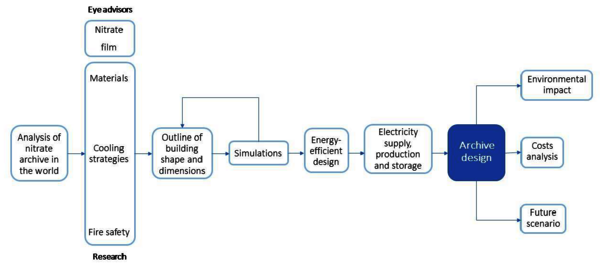| EngD trainee | Daria Zendri |
| Project | Design of a sustainable vault for the preservation of a nitrate film collection |
| University supervisor | dr. ir. Roel Loonen |
| Company supervisor | Walter Swagemakers |
| Name of company | Eye Filmmuseum |
| Period of project | March 2021 – February 2023 |

The Eye Filmmuseum is the national film institute and museum for film heritage and film art in the Netherlands. Approximately 8% of Eye's total film collection consists of nitrate film, a material used for motion picture film, that becomes unstable when good climate conditions such as low temperature, around 2°C, and low relative humidity, between 20 and 30% are not maintained. If big quantities of deteriorated nitrate are stored together, they may spontaneously ignite. Nitrate film burns quickly, produces poisonous smoke containing toxic fumes and, once it is burning, it is hard to put out. Since the collection is currently held in old bunkers that cannot provide a proper climate, the Eye Filmmuseum wants to move its collection to a new depot that meets the requirements for a good preservation of the nitrate film collection. This EngD project aims at creating a set of recommendations for the configuration of a new nitrate archive for the Eye Filmmuseum. Solutions for different aspects of the building are explored, including materials, cooling strategies, dehumidification and ventilation, fire safety, energy efficiency, environmental impact, and costs.
The material considered for the building structure is Cross Laminated Timber, due to its good hygrothermal properties, its renewability, and for its behavior in case of fire. Passive cooling strategies are analyzed; shading elements, such as a roof canopy, protect the building from direct solar irradiance. Low emissivity and reflective materials can further lower the cooling demand of the building. Energy efficient mechanical cooling can be provided by an air chiller or heat pump; a desiccant wheel is the most efficient system for dehumidification, considering low temperature and low relative humidity requirements.
Regarding fire safety, two types of shelves are considered for storing the collection, movable and fixed, which require different building design and fire suppression systems. Movable shelves require compartmentation, to avoid the spread of fire in the adjacent vault; this is done by using rock mineral wool, a non-flammable material. Fixed shelves are open faced and made with steel-clad insulation material, which prevents the fire from spreading from the shelves to the vault. Additionally, with the use of a fire suppression system, the compartmentation is not necessary. Due to the different requirements, the two types of shelves lead to two different building configurations. In both designs, fire doors and explosion vents are necessary.
To assess the yearly electricity demand of the archive building, considering its indoor climate requirements, an outline of the building shape is created, according to the collection size, and building energy simulations are run. To cover yearly electricity demand, different number of photovoltaic panels are also considered in the simulation. The PV system is coupled with batteries of different sizes to increase the self-consumption of electricity and lower the dependency from the grid.
The sensibility of a thermal energy storage using ice slurry for the archive building was explored. By using the surplus electricity produced by the PV system during the day, ice slurry is produced and stored in tanks. During the night, when there is no electricity production, the ice slurry melts and provides free cooling to the vaults. Considering different number of PV panels, the cooling capacity of such systems seems to be enough to cover the night cooling demand of most nights during the entire summer.
The behavior of an emergency battery is analyzed, to bridge the cooling demand during possible blackouts. It was calculated that an emergency battery of at least 20 kWh can help to provide enough electricity to the system for at least 26 h, considering a building with and without fixed battery and with blackouts happening both in summer and in winter.
The environmental impact of the building was analyzed for different aspects. The impact of the CLT structure of the building was compared to two other building structure types, namely concrete and lightweight timber frame, considering embodied energy and embodied carbon. The data is collected from Environmental Product Declarations of different materials.
Finally, a cost estimation of the different scenarios is made; the amount of materials used for each scenario is calculated and the costs of each material are collected from supplier. A tool was used to assess indirect and additional construction costs. A range of the estimation of each scenario is given, and the cost is compared to two nitrate archives, built in the last decade, considering the rise in construction cost.
